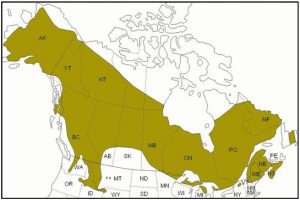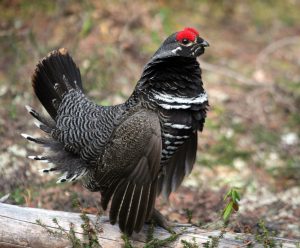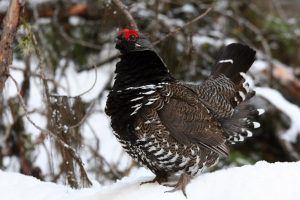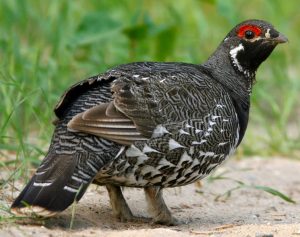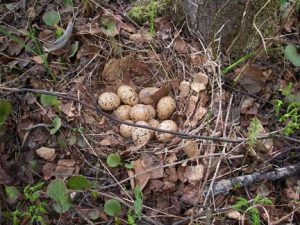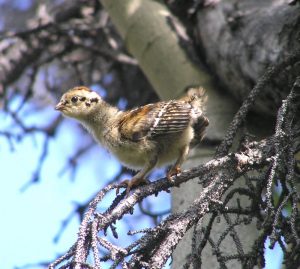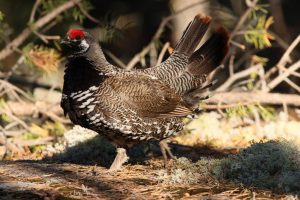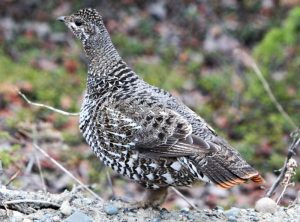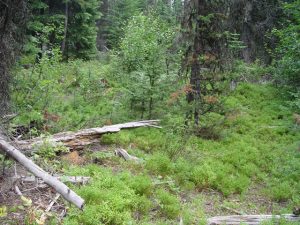Spruce Grouse
The spruce grouse is a sturdy bird with dark plumage found in the coniferous forests of North America. It resembles a large chicken in its appearance and is nicknamed ‘fool’s hen’.
Scientific Classification
| Kingdom | Animalia |
| Phylum | Chordata |
| Class | Aves |
| Order | Galliformes |
| Family | Phasianidae |
| Subfamily | Tetraoninae |
| Genus | Falcipennis |
| Scientific Name | Falcipennis Canadensis |
Quick Information
| Other Names | Canada Grouse, American Spruce Grouse, Spruce Partridge |
| Size | Length: 38-43 cm Wingspan: 57 cm |
| Weight | Males: 550-650 grams(1.2-1.4 lbs) Females: 450-550 grams(0.99-1.2 lbs) |
| Color | Adult males: gray on the backs, black undersides, white spots along the sides, a patch of red bare skin just above the eyes Adult females: mostly brownish to gray, abundant brown and white barring Juveniles: resemble the color patterns of the female, have white or buff colored feather tips |
| Distribution | Throughout Canada, parts of the Northern United States including Alaska |
| Habitat | The spruce grouse is one of the most arboreal among grouses; found in coniferous forests of spruce, pine or fir |
| Subspecies |
|
| Vocalizations | Mostly silent, uses certain vocalizations to repel predators and unwanted territorial visitors and maintain its brood; sounds produced resemble an array of hisses, purrs and humming noises |
| Lifespan | Up to 5-6years in the wild; rare specimens believed to have lived for 13 years were found in a study done in Southwestern Alberta |
| Diet | Pine and spruce needles throughout the year; during the summer, it feeds on insects |
| Adaptations |
|
| Clutch Size | 4-7 tawny olive or buff colored eggs with brown uneven shades, about 40mm in length. |
| Incubation Period | 23-24 days |
| Predators | Eggs are devoured by red squirrels, foxes and weasels; adult spruce grouses are taken by hawks, foxes, owls, coyotes, pine martens. |
| IUCN Conservation Status | Least Concern |
Behavior
Although arboreal, the spruce grouse forages both in trees and on the ground for food. The spruce grouse does not have a vocal sac to inflate during wooing the opposite gender or territorial fights. To make up for the lack, it uses a wing-clap.
The spruce grouse is more of a walker than a flier, flying only for short distances, generally from one tree to another.
Mating and Reproduction
Polygamous males usually have territories that are visited by females specifically for mating. When the mating is concluded the female takes up the responsibility thereon. A nest is built during early May and early July, mostly in the ground, but also sometimes in a low coniferous branch or a fallen tree. It is bordered by grasses, leaves and feathers.
One egg is laid per day, with about 33 hours of gap between two eggs. Once the eggs hatch, the young are able to walk as soon as they dry up, which takes around 8 hours.
Life Cycle
The baby spruce grouse can start fluttering at 1 week old. The brood stays in cohesion with the mother, which cares for them for up to 5 weeks. After attaining an age of 70-100 days, the young leaves its family and becomes independent. The females reach sexual maturity a year after they are born and the males after 2 years.
Interesting Facts
- The Franklin’s grouse has been recently split from the spruce grouse and has its own subspecies inhabiting Prince of Wales Island and the Alexander Archipelago of southeast Alaska.
- It can stand motionless in a particular spot and blend in such due to its camouflage that a potential predator won’t even realize that it is there.
- Since during the winter season, it demands more food in order to maintain its mass and energy, the gizzard of the spruce grouse grows up to seventy five percent and other areas of the digestive tract expand to about forty percent of their size to accommodate the increased diet.
References:
- https://www.allaboutbirds.org/guide/Spruce_Grouse/lifehistory
- https://en.wikipedia.org/wiki/Spruce_grouse
- https://www.dec.ny.gov/animals/7078.html
- http://www.audubon.org/field-guide/bird/spruce-grouse
Published on July 25th 2016 by Sudipto Chakrabarti under Coniferous Forest Animals.
Article was last reviewed on 5th December 2024.


